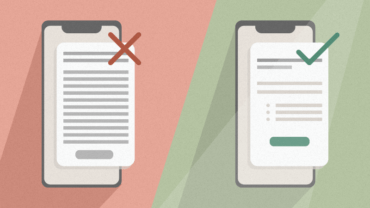Why You Must Start by Defining a Clear Behavioral Goal for Every Marketing Project – with Matt Wallaert

Matt Wallaert explains how to think about consumer behavior and write behavioral statements for your marketing goals using insights from behavioral science.
In this article, you’ll discover:
- Why clear behavioral goals can help marketers avoid common mistakes when starting on projects;
- How to write a behavioral goal (or statement) for your next project or role; and
- How to define each variable in a behavioral statement.
If you’re familiar with applied behavioral science, you’ve probably come across the concept of a behavioral statement. Often used to define the missions of large tech companies, behavioral statements are a structured way of articulating what your goals should be, and how the world will change if you achieve them.
But behavioral statements aren’t just for CEOs and Silicon start-ups. Marketers, UX-designers, content writers, and anybody else working downstream of top-line goals can use behavioral statements to make their own projects more efficient, aligned, and impactful.

Discover ground-breaking ideas and fascinating solutions.
To find out how and why marketers should write effective behavioral statements, we spoke to Matt Wallaert, an applied behavioral scientist for over 20 years, who’s used behavioral statements to solve problems for start-ups and Fortune 500 companies alike.
Behavioral statements are a structured way of articulating what your goals should be, and how the world will change if you achieve them.
His book, Start at the End, is a beginner’s guide to applied behavioral science, walking readers through the mind-expanding process of making behavior change the focus of their work. “It’s all about centralizing behavior in everything that we do,” Matt says. “Recognizing that the outcome of everything is some sort of behavior.”
Let’s look at how behavioral statements can help you avoid common mistakes when starting a new project.
Who cares about behavioral statements?
Thinking about marketing projects in terms of behavior doesn’t always come naturally. Often, inspiration strikes and creative teams dive into their own ideas without pinning down what exactly the behavior is that they want to achieve.
Maybe there’s a vague goal, such as increasing sales or clicks, but what exactly do those words mean without context? As Matt says, “People say lots of things like, we want people to engage. But what do you mean by engagement? Are you thinking about time on site, or the number of logins, or returning users?”
By asking, “What’s the behavior change I want to achieve in my target audience?” behavioral statements help marketing teams set clear, actionable goals that produce real outcomes. They also reduce the risk of working on products, content, or solutions that don’t actually solve the issue they were intended to tackle.
By asking, “What’s the behavior change I want to achieve in my target audience?” behavioral statements help marketing teams set clear, actionable goals that produce real outcomes.
Matt recommends thinking about project planning as a form of science fiction. “We all do things because we want the world to be different than it is today, to create a world that does not yet exist. But in order to do that effectively, we have to envision what that world looks like. Otherwise, how can we navigate our way there? The behavioral statement helps us understand what we’re looking for.”
“It’s like any journey,” Matt says. “When you set out, being off-course by one or two degrees doesn’t look like much. But the farther you go, the wider the gap becomes until you miss the destination entirely.”
What exactly does a behavioral statement look like?
The abstract version of Matt’s carefully honed behavioral statement goes like this:
When [A target audience] who [Have some limitations] want to [Motivation], they will [Behavior], as measured by [Data].
To write your own behavioral statement, you’ll need to define what each variable means for your context and fill in the gaps. For example, a behavioral statement for this article might be:
When [a copywriter, UX designer, or strategist] who [speaks English] wants to [find out what the first step is in every project they work on], they will [read this article], as measured by [the number of readers who read until the end].
Statements can be as narrow or as wide as you need. They can capture smaller tasks like designing a newsletter, large projects like an ad campaign, or you can write statements that define each role in your team. Matt suggests that employees “take on the most ambitious behavioral statement that they would be willing to be held accountable for.”
Of course, behavioral statements are also used to encompass entire businesses. Matt likes to use Uber as an example of a company that has developed a clear, top-level behavioral statement:
When [any person] who has [a smartphone with service and the Uber app downloaded] wants to [get from point A to point B], they will [take an Uber], as measured by [the number of rides taken].
Regardless of scope, a good behavioral statement is:
- binary (it’s either met or not met),
- isn’t vulnerable to misinterpretation, and
- can be easily measured.
Let’s go through each variable in the behavioral statement to see what they look like. Matt recommends starting with limitations, for reasons you’ll see below:
Limitations
Limitations help determine the scope of your behavioral statement. They are criteria that your target audience will need to meet in order to be able to carry out the intended behavior. They should also be binary things that do or don’t apply to your users.
Don’t confuse limitations with inhibiting pressures (another common behavioral science term), which make a target audience less likely to exhibit behaviors and are affected by your interventions. For example, a limitation might be a person’s geographical location, while an inhibiting pressure could be their opinion of your brand.
When it comes to limitations, Uber might decide that wheelchair users, or people outside of the US, or people without credit cards are not going to be included in their behavioral statement. Marketers might rule out non-English speakers, Android users, or people who already interact with newsletters.
Often, this part of the process is about determining who isn’t covered by the behavioral statement, rather than who is. Keep the scope narrow and focused on your current capabilities. A new statement can widen the scope later on when your bandwidth broadens.
Target Audience
Matt often starts with limitations, then finds his target audience by looking at the set of people who are left over when all of the limitations are applied.
When determining audiences, he recommends sticking with how people self-describe. For instance, if customers at your eCommerce store think of themselves as “small business owners” then that’s how you should think of them, regardless of whether they fit an official definition. It’s all about finding a cohesive population that can be defined in their own terms.
People rarely think of themselves as demographics, so don’t make your target audience too general. For instance, a target audience shouldn’t read “parents between 30 and 40 years old with disposable income” unless you have genuine insights or evidence to support that kind of definition.
Instead, “a young parent who shops for childcare products online” may create a better alignment between your statement and your audience’s self-identity, making it more likely that audiences will feel seen and heard by your communications. Use the target audience variable to describe the role that your customers feel they naturally fit.
Motivation
Like target audiences, defining motivations for behaviors is about looking at how consumers describe themselves and their intentions, rather than trying to psychoanalyze people to uncover a “real” motivation in the background.
Again, Matt recommends thinking from your target audience’s perspective. “What would they say? How would they define what they are trying to do? If I asked you, ‘Why did you take an Uber today?’ whatever your answer is would be your motivation. This is not House MD—we’re not assuming people are lying. This is people’s self-described motivations.”
If you don’t know why your target audience is motivated to interact with your product or service, that means going out into the world and performing consumer research.
Be careful not to mix motivations with promoting pressures (the opposite of inhibiting pressures). A promoting pressure is a secondary reason to perform the intended behavior, while motivation is the central, dominant reason behind it.
If a person doesn’t possess the motivation in your statement, they won’t perform the behavior, even if promoting pressures are satisfied.
Here’s an example: if you’re shopping for a car and decide to buy a BMW, there are likely several promoting pressures involved. Perhaps you saw an enticing ad, or think that European cars are better investments, or that driving a BMW will make you look cool. These and other pressures should form part of a wider intervention strategy but shouldn’t go into a behavioral statement because they’re unlikely to capture the primary reason why you walked into the BMW dealership as you’d describe it.
Your motivation is actually far simpler—you wanted to buy a car. Promoting pressures involving investments and looking cool might influence your decision, but they won’t cause the intended behavior change by themselves. Likewise, satisfying those promoting pressures in other ways, such as by advising you on your stock portfolio or buying you a new fashionable wardrobe, are unlikely to affect whether or not you continue shopping for a new ride.
In other words, if a person doesn’t possess the motivation in your statement, they won’t perform the behavior, even if promoting pressures are satisfied.
Behavior
The final two variables, behavior and data, are closely linked. Matt calls behavior “the qualitative” and data “the quantitative.”
As with other variables in the statement, the behavior you choose should be tangible, binary, and easily measurable. The more distinct and observable the behavior, the more targeted your interventions become, the easier they are to measure, and the less opportunity there is for misinterpretation.
For example, if a SaaS company was writing a behavioral statement to help increase usage, they’d need to find a tangible binary behavior that they could easily measure. Choosing “people will use our software” as the behavior isn’t sufficient because it could be interpreted as a number of different behaviors and measured in different ways.
Instead, the behavior might look more like “people will log into our software more than twice per week and stay for a minimum of 30 minutes.” Here, it becomes easier to say whether people have or haven’t performed the intended behavior.
To hone behaviors, Matt suggests thinking in terms of counterfactuals. What would a person who is not performing the behavior look like? Keep refining your description of the behavior until there is a single, clear difference between the person who is performing as you want, and the person who isn’t. That difference is the behavior that should be written into your statement.
Data
Choosing the right data metric for your statement is about finding a specific articulation of your intended behavior.
The target audience above who were motivated to buy a car performed the intended behavior of buying a BMW. What’s the specific articulation of this behavior? Perhaps it’s simply total monthly sales from your dealership. But maybe it’s something more specific, like the type of cars sold, or average cars sold per day.
Decisions about the specificity of your measurements always depend upon context, but they should be as detailed as needed to isolate the intended behavior from other things happening in the wider business.
The more accurately you’ve defined your behavior, the easier it is to choose an appropriate metric. The SaaS company that defined its intended behavior as “using our software” will have a hard time finding a single data point to measure. On the other hand, the SaaS company whose intended behavior is “logging in more than twice per week and staying for longer than 30 minutes,” knows exactly what they need to measure to prove their behavioral statement true or false.
Key takeaways
- Make sure your behavioral statement can be proved true or false. Binary statements let you know when you’ve achieved your goal and are less vulnerable to reinterpretation.
- Don’t use vague terms like “engagement” or “sales” in your statement. Instead, articulate exactly the type of behavior change you want. When a behavior has multiple meanings, it becomes hard to find a single data point to measure it by.
- Instead of making your behavioral statement a moon shot, use lots of limitations to help describe your current capabilities and narrowly define your audience. This will make sure your statement is actionable.






